U.S. Department of Transportation
Federal Highway Administration
1200 New Jersey Avenue, SE
Washington, DC 20590
202-366-4000
Federal Highway Administration Research and Technology
Coordinating, Developing, and Delivering Highway Transportation Innovations
|
Research & Technology Transporter This newsletter is an archived publication and may contain dated technical, contact, and link information. |
|
| Publication Number: N/A Date: March 2005 |
Publication Date: March 2005
|
Adverse weather conditions have a major impact on the safety and operation of the Nation's roads. Weather affects driver behavior, vehicle performance, pavement friction, and roadway infrastructure. The Federal Highway Administration (FHWA) conducts research to better understand the impacts of weather on roadways and traffic flow, and to develop strategies and tools to mitigate those impacts.
To enhance these research efforts, FHWA is installing a new weather station behind the Traffic Research Laboratory (TReL) at the Turner-Fairbank Highway Research Center (TFHRC) in McLean, VA. Data from the weather station will support FHWA research on road weather management and weather information systems for highway applications. The station, mounted on a 9-meter (30-foot) tower, will include sensors for wind, temperature, barometric pressure, and visibility. The station also will include a global positioning system (GPS) surface observing system.
The data from these systems will be used to support research into advanced traffic models. TReL routinely develops traffic simulation models to study the impacts of various factors on traffic movements and driver behavior and to assess the effectiveness of possible operational countermeasures. The new weather station will provide TReL researchers with a greater capacity to test various methods of incorporating weather into simulation and analysis models. Data from the new weather station will be used in tests to identify the model enhancements needed to achieve a more accurate representation of vehicle performance and driver response to weather.
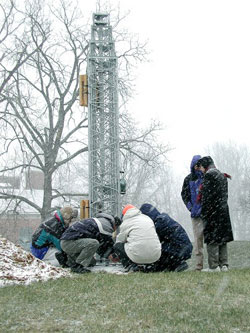 |
| An FHWA team begins installing the new weather station. Once the station is up and running, it will gather data to support FHWA research on road weather management. |
The GPS data also will provide centimeter-level navigation accuracy to support a Vehicle Infrastructure Integration initiative underway at TFHRC. The initiative, sponsored by the U.S. Department of Transportation, American Association of State Highway and Transportation Officials, and several major automobile manufacturers, is exploring communication and data exchange between vehicles and the roadside. Forthcoming research could reveal how vehicles and roadside stations might communicate information on vehicle speed, wind conditions, air temperature, sudden braking, and more than a dozen other indicators.
In addition to FHWA, the National Oceanic and Atmospheric Administration (NOAA) and other organizations that require current weather information will have access to data gathered by the new weather station. NOAA's Forecast Systems Laboratory, for example, will use the data to improve weather forecasting and climate monitoring. Using the GPS surface observing system, NOAA will contribute to national weather models by compiling data on precipitable water vapor.
For more information on the weather station, contact:
Rudy Persaud 202-493-3391 rudy.persaud@fhwa.dot.gov
Highway users, transportation agencies, contractors, suppliers, researchers, public interest groups, and communities have contributed to the direction of highway research and benefited from the resulting technologies. These benefits include improved safety, reduced congestion, and increased longevity of the highway system. Despite these benefits, however, several external review bodies have recommended expanded stakeholder involvement in the development and review of the Federal Highway Administration's (FHWA) Research and Technology (R&T) program. In particular, the Transportation Research Board's (TRB) Research and Technology Coordinating Committee Special Report 261, The Federal Role in Highway Research and Technology (2001, ISBN 0-309-07246-8) called for systematic stakeholder involvement in the R&T process and specifically in the merit review and evaluation processes.
To meet the challenge of enhancing stakeholder involvement, FHWA's Corporate Master Plan for Research and Deployment of Technology & Innovation (FHWA-RD-03-077), originally published in 2003, set forth a bold new process for developing and deploying research and technology. An important consequence of this document was the decision by FHWA to create an Office of Corporate R&T. Following creation of the office, the staff determined that an important first step was to identify best practices in stakeholder involvement.
To identify the best practices, the Office of Corporate R&T and TRB's Conduct of Research Committee organized a panel discussion in January 2005, entitled "Creating Dynamic Stakeholder Networks: The Key to Effective Research and Technology Deployment." FHWA's Deputy Administrator J. Richard Capka served as moderator of the panel, which included representatives from the New York State Energy Research and Development Authority, the National Institute of Standards and Technology, and the National Science Foundation. The panelists discussed how Federal and State research programs could collaborate to ensure continual stakeholder involvement in all phases of the R&T lifecycle.
The session generated several important insights regarding the steps FHWA could take to establish an R&T program focused on stakeholders. FHWA could, for example,
Establish multiple participation venues, such as public meetings or formal program reviews by standing advisory groups, to promote stakeholder involvement and ensure that individuals with different levels of knowledge and experience can participate in the R&T process
Educate stakeholders on the mission and objectives of R&T programs
From the start, identify the benefits and costs of outsourcing stakeholder involvement activities, such as using third parties to conduct public or advisory group meetings
Learn to appreciate the important role of stakeholders in promoting R&T programs before legislative bodies
FHWA posted the presentations from the panel discussion at www.fhwa.dot.gov/crt/index.cfm. The TRB panel discussion is the first initiative among many that FHWA is planning in an effort to engage stakeholders throughout the R&T process.
John Munro 202-493-3368 john.munro@fhwa.dot.gov
The public's expectations for the outcomes of local transportation projects often differ from those of engineers, architects, community planners, and transportation professionals. These divergent views can make it difficult to persuade interested groups to cooperate and create projects that meet all of a community's needs, such as preserving an area's setting and character, maintaining a community's values, and meeting users' needs. A new movement in urban design, known as context sensitive solutions (CSS), is helping to overcome this challenge and sustain the character, value, and needs of communities.
CSS is a collaborative approach to developing and redesigning transportation facilities that fit into their physical and human environment while preserving aesthetic, historic, and environmental values. CSS contributes to the community, improves safety and mobility, and involves civic leaders and community stakeholders in the process of designing streets and roads that match their physical settings. The CSS process implements a variety of principles, such as enhancing communication with project stakeholders, establishing multidisciplinary teams that include members of the public, and requiring consideration of alternatives to help build consensus.
The Federal Highway Administration (FHWA) recognizes the importance of CSS and adopted it as one of its "vital few" strategies. FHWA anticipates that by 2007, officials at every State department of transportation (DOT) will use CSS in the development of projects. Since implementing CSS can be complex and FHWA wants to help State DOTs incorporate CSS into future projects, the agency created a new online peer-networking Web site at www.contextsensitivesolutions.org. The new site enables transportation professionals faced with balancing highway improvement and environmentally sensitive design to share information about CSS, such as project examples, case studies, and photographs. The new Web site also enables elected officials and concerned citizens to participate in the transportation planning process through an online community where everyone with a vested interest in a project can share ideas.
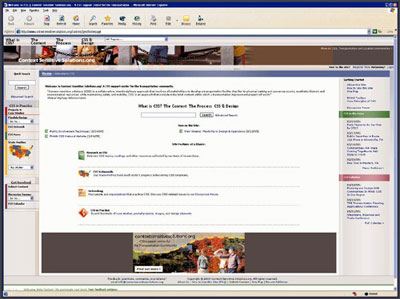 |
| The new context sensitive solutions Web site. |
One section of the site allows users to sort the case studies by project type. Easily accessible menus enable users interested in a particular measure, such as using curb extensions, to learn about CSS-based projects employing that solution. Another section of the site features current CSS news and events. Menus in this section enable users to select specific topics or browse the entire range of available documents. Another section, which is still under development, is an online forum. When the forum is complete, users will be able to discuss issues and share thoughts on CSS implementation via the Internet.
For more information about CSS or the online resource, contact:
Keith Moore 202-366-0524 keith.moore@fhwa.dot.gov
In 2000, the Office of Pavement Technology and Office of Infrastructure R&D at the Federal Highway Administration (FHWA) created an annual workshop series to help FHWA engineers learn about developments in pavement and materials technology and practices. The goal is to provide transportation engineers with widely applicable information that they can use and share with their colleagues. During the past 5 years, the workshops have covered a broad range of topics, including state-of-the-art technology in pavement testing, quality assurance, pavement smoothness, and the 2002 Pavement Design Guide.
The Fifth Annual Pavement/Materials Workshop focused on three innovative techniques-design-build methods, warranties, and performance specifications—that highway agencies are using to save time and money while assuring quality on construction projects. More than 70 pavement and materials engineers from FHWA attended the 3-day workshop, which was held in December 2004 in Arlington, VA.
In a presentation during the workshop, Patrick Drennon, director of design-build engineering for Parsons Brinckerhoff, introduced participants to the design-build procurement process. Traditional contracting methods, which separate design and construction contracts to provide a system of checks and balances for quality and price, tend to extend the time necessary to complete the project. The design-build technique, however, combines the design and construction phases into one contract, which speeds delivery of the finished product, reduces costs, and promotes innovation. In the past, design-build contracting was more prevalent in private sector work. However, design-build contracting for public sector projects has become much more common. One recent example is the reconstruction of a 26-kilometer (16-mile) section of Interstate 15 in Utah. With the help of design-build contracting, the State completed the project 5 months ahead of schedule and $30 million under budget.
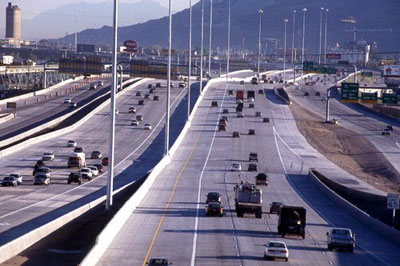 |
| The design-build procurement process, one of the topics at the FHWA's Fifth Annual Pavement/Materials Workshop, was used to facilitate the reconstruction of Utah's I-15, shown above. |
In another workshop session, Nancy Smith, a well-known attorney in the fields of design-build and warranties, and Charlie Trujillo, the previous Secretary of Transportation for the State of New Mexico and engineering manager representing Parsons Brinckerhoff, focused on warranties, which guarantee that contractors will repair or replace specified portions or parts of a transportation project for a certain time period after construction is complete. Warranties can be based on materials and workmanship, such as whether project materials conform to the sponsoring highway agency's requirements or if the work complies with the agency's plans and specifications. Other warranties are based on performance, or whether a product, such as pavement, performs as specified over a certain time in service. Several State departments of transportation (DOT) use warranties to assure quality on projects while reducing oversight costs. The Michigan DOT, for example, negotiated warranties on 473 preventive maintenance projects and 131 rehabilitation projects from 1996 to 2002, saving money on construction oversight as a result.
Dr. K.N. Gunalan, a geotechnical/pavement engineering manager at Parsons Brinckerhoff, discussed the role of performance specifications, which govern the characteristics of the final product, such as pavement durability or skid resistance. Traditionally, most highway projects were built using method specifications, which prescribe the materials and construction methodology that contractors had to use on a project. Performance specifications, in contrast, require a broader vision of the project goals, quantified performance criteria, and performance requirements, providing the contractor with more flexibility in selecting design and construction methods that will meet the highway agency's goals.
Gene Clark 202-366-4597 gene.clark@fhwa.dot.gov
Prior to the passage of the Transportation Equity Act for the 21st Century (TEA-21) in 1998, transportation staff responsible for planning new facilities integrated safety into the development and design of projects on occasion. Research showed, however, that safety practitioners and transportation planners often were unable to coordinate or communicate effectively about the integration of safety into planning. The passage of TEA-21, however, mandated that State departments of transportation (DOTs) and metropolitan planning organizations (MPOs) incorporate safety as a priority factor in their planning processes.
To meet TEA-21's requirements, transportation planners and safety practitioners developed a discipline known as "safety conscious planning" (SCP) to ensure that safety receives the same attention as other priorities during the transportation planning process. In recent years, the Federal Highway Administration (FHWA) and several other agencies have undertaken various efforts to increase awareness of SCP, including a 2-day training course. The course, which was developed under the auspices of the National Transit Institute, focuses on familiarizing State, regional, and local planners with safety challenges and helping them find the resources to overcome those challenges.

In January 2005, FHWA sponsored the SCP training course, which was hosted by the Atlanta Regional Commission in Atlanta, GA. Participants included representatives from 35 organizations, such as the Georgia Department of Transportation (GDOT), the Metropolitan Atlanta Regional Transit Authority, the Georgia Governor's Office of Highway Safety, the Georgia Regional Transportation Authority, and several county governments and local MPOs.
During the course, participants learned how to weave safety into metropolitan and statewide transportation planning and how to monitor progress on integration and implementation. In addition, participants identified key safety factors for all modes of transportation. The participants also examined the benefits of SCP, such as reducing the human and economic consequences of motor vehicle crashes. Safety solutions integrated during the planning stage tend to be relatively low-cost and usually yield significant results for the investment.
The central message of the training was the value of the collaborative process. Transportation planners and the safety community can creatively cultivate partnerships to address both safety and transportation goals. The partnerships can help agencies use resources more effectively by sharing critical information and by providing joint funding for projects. Working independently, the safety and transportation communities may lack sufficient resources to accomplish some goals. But by working collaboratively, they significantly improve their chances of reaching all of their goals.
Other resources and activities that FHWA has developed to help States meet TEA-21's SCP requirement include a Web site that serves as an information clearinghouse at www.fhwa.dot.gov/planning/SCP, peer exchanges, scanning tours, and best practice documentation and communications materials. In addition, FHWA has developed and held SCP forums in 19 States to help increase awareness of the processes involved in transportation and safety planning at the State and local levels while building relationships between transportation planners and safety professionals. FHWA anticipates holding the following forums in four additional States in 2005:
Information on the SCP course and schedules are available at the National Highway Institute Web site at www.nhi.fhwa.dot.gov and the National Transit Institute Web site at www.ntionline.com/Courses.asp.
Robert Ritter 202-366-2139 robert.ritter@fhwa.dot.gov
Helping middle school students hone the skills needed to solve real-world problems is the core goal of the National Engineers Week Future City CompetitionTM. The competition encourages interest in engineering by providing hands-on applications for math and science, and helps develop workplace skills such as imagination, troubleshooting, and teamwork. Transportation systems took top billing in this year's competition, in which students designed model cities that showed how citizens would live, work, and travel in the future. As part of the competition, students submitted essays on how their future transportation systems would use basic aggregates—stone, sand, and gravel—to facilitate travel.
Teams from 32 middle schools, all of whom were winners of regional competitions, came to Arlington, VA, to participate in the Future City national finals in February 2005. Working with a teacher and a volunteer engineer from the local community, each team created a future city using SimCityTM software, built a scale model of part of the future city, and wrote an abstract and essay. At the competition, the students defended their designs before a panel of judges.
The winner of this year's essay challenge, sponsored by the National Stone, Sand, and Gravel Association, was a team from St. John Lutheran School in Rochester, MI. The team's future city, Solaratoll, features a transportation system named SMART, for Super Magnetic Aggregate Road Technology. "The road system is constructed with a volcanic rock aggregate base (harvested from magma) and Magnetically Enhanced Magma (MEM) binder," the team's essay writes. "By adding a magnetic powder as a binder to the aggregate and controlling the way the magma cools, MEM forms individually insulated particles into a hard concrete material and develops a polarized magnetic field, which actually creates the energy that drives our vehicles down the road."
Aggregates also played a role in the city that earned the Federal Highway Administration's (FHWA) special award at the Future City finals. A team from Duchesne Academy of the Sacred Heart in Houston, TX, won the 2005 Best Transportation System Award for its city, Emerald Isle. Roads in the city are made of concrete that includes locally available sand and limestone as aggregate components.
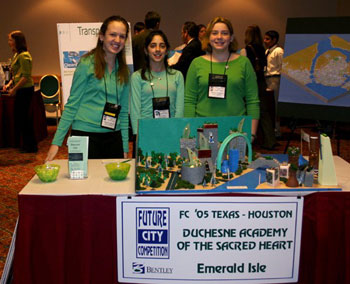 |
| A team from Duchesne Academy of the Sacred Heart in Houston, TX, won this year's Best Transportation System award, sponsored by FHWA, at the Future City competition. Shown with the model of their prototypical city, Emerald Isle, are (left to right) Katherine McKenna, Kimi Rafie, and Theresa Sturdivant. |
L'Etoile Directice, a city of the future engineered by students from St. Thomas More Catholic School in Baton Rouge, LA, won first place overall in the Future City competition. The city, featuring star-shaped artificial barriers to lessen the impact of hurricanes, is covered by a self-healing plastic dome built to withstand major winds.
"The creativity of these students was incredible—pavements that generate power, genetically altered micros for healing plastics, cities that breathe and clean the atmosphere," said Joseph Toole, FHWA's associate administrator for professional and corporate development and a Future City judge. "In addition to their engineering imaginations, it was amazing to see the poise the teams had when presenting their projects on stage in front of TV cameras and an audience of 400, and then being grilled by our panel of judges."
FHWA sponsors the annual transportation system award to encourage students to consider careers in engineering and transportation, to promote appreciation of the role that transportation plays in enhancing quality of life, and to provide insight into the challenges faced by highway engineers.
Kathleen Bergeron 202-366-5508 kathleen.bergeron@fhwa.dot.gov
The Civil, Environmental, and Infrastructure Engineering Department at George Mason University (GMU) offers bachelor and master of science degrees in civil and infrastructure engineering. The university does not, however, have traditional civil engineering laboratories at its campus in Fairfax, VA. Consequently, undergraduate civil engineering students at GMU typically have not had an opportunity to gain hands-on experience with traditional materials testing and other laboratory skills.
To help educate future transportation engineers, the Federal Highway Administration (FHWA) and GMU recently signed a memorandum of understanding (MOU) to provide civil engineering students with opportunities to access the state-of-the-art research laboratories at FHWA's Turner-Fairbank Highway Research Center (TFHRC) in McLean, VA. Located approximately 24 kilometers (15 miles) from the GMU campus, TFHRC is FHWA's leading research and development center and home to 24 laboratories where research is conducted to support FHWA's mission.
The MOU enables students to participate in field trips to TFHRC to observe the work being performed in the laboratories. The memorandum also provides for development of an internship program at FHWA for GMU undergraduate students. Participants in the internship program will observe and contribute to experimental design and testing and learn about the economics and marketing of engineering products.
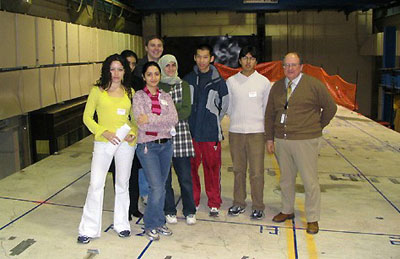 |
| Some of the first students from George Mason University to take advantage of the new partnership between FHWA and GMU are shown here with FHWA's Dr. Steven Chase. Students pictured left to right are Gabriella Espinoza, Baharak Mohammadzadeh-Fakhri, Solol Baniahmad, Roman N. Antonio, Soudeh Baghernejad, Tue Q. Phung, Israel E. Arteaga. |
Graduate students also will have an opportunity to participate in independent study supervised by GMU faculty members and FHWA staff. In addition, the MOU enables scientists and engineers at TFHRC to collaborate with GMU faculty members on research projects.
In addition to these activities, a group of nine undergraduate engineering students from GMU are participating in a one-credit elective course in January 2005 that enables them to interact with FHWA staff and gives them greater access to TFHRC's laboratories. For students taking the course, FHWA researchers provide 13 weeks of hands-on instruction designed to review common testing and experimental methods that civil engineers encounter in their professional practice. Instructors use a combination of short lectures, individual readings, and exposure to testing and measurement methods used in research areas such as structures, pavements, soils, and hydraulics.
FHWA has a similar memorandum of understanding with The George Washington University, located in Washington, DC. If the relationships with the two universities prove successful, TFHRC anticipates expanding its partnerships to other local universities that offer civil engineering programs.
Steve Chase 202-493-3038 steve.chase@fhwa.dot.gov
To identify the challenges to improving highway safety, the Federal Highway Administration's (FHWA) Office of Safety, in partnership with the Office of Professional and Corporate Development, conducted a survey on highway safety in March 2002. The results of the survey led to several recommendations, including offering safety courses.
Acting on this recommendation, the National Highway Institute (NHI) is now providing innovative training for transportation professionals focused on fostering sustainable collaboration between the intelligent transportation system (ITS) and highway safety communities. One of the newest classes in this training program is Improving Highway Safety with ITS (#137044).
In this class, instructors provide participants with an overview of the use of ITS in technology applications, safety planning, project execution, and other areas to improve highway safety at the project and strategic planning levels. In addition, the course will enhance collaboration between ITS and safety personnel and provide participants with the basic tools and resources needed to select the appropriate ITS solutions for addressing various issues.
NHI designed the new course to assist safety and ITS professionals, roadway planners, operators, designers, and maintenance personnel. Course planners suggest that participants have some experience in either ITS or highway safety and have familiarity with strategic planning activities and goals or the ITS strategic activities and initiatives in their State.
Instructors will present the course using Microsoft® PowerPoint® slides, workshops, teamed problem solving activities, and sessions for developing action plans. After completing the course, each participant will have learned about:
NHI conducted a pilot course in February 2005 and intends to make the course widely available in November 2005. FHWA also has developed a 1-hour executive summary of the course for senior officials.
Bud Cribbs 703-235-0526 bud.cribbs@fhwa.dot.gov